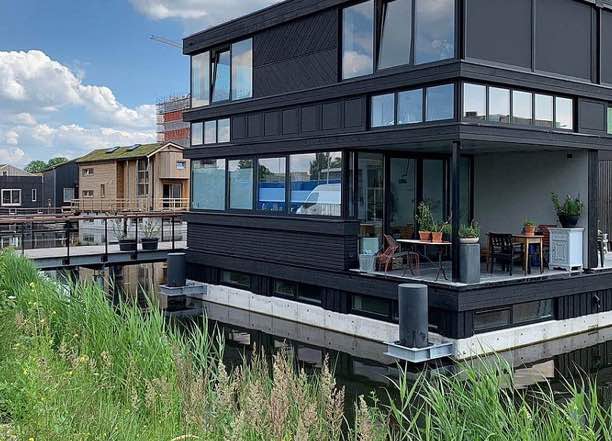As sea-level rise threatens cities throughout the world, some are looking at how humans can adapt. In North Amsterdam, a collaborative team created a floating neighborhood called Schoonschip on a canal. It consists of 46 dwellings, more than 100 new residents, and seeks to be the most sustainable neighborhood in Europe.
The neighborhood was designed by the architectural firm Space & Matter and a multidisciplinary team of consultants and future inhabitants. Each dwelling has a unique architectural style and various exterior finishes. Construction at Schoonschip will be completed later this year.
According to the project website, “Seventy percent of the world is covered in water, and the good thing is that we can easily live on it! Since urban areas struggle with high density, we should make better use of the space on the water. With Schoonschip, we want to set the example and show how living on water can be a great and better alternative for people and our planet.”

Sustainable, Resilient Homes
Numerous design features enable these homes to conserve natural resources while decreasing pollutants.
Water Use
Despite abundant water, the project uses ambient water for flushing toilets and irrigating, conserving this precious resource. For drinking water, residents choose between the municipal water supply or a self-sufficient water purification system. Also, the wastewater treatment process collects energy and nutrients during the process. Some units collect rainwater for flushing toilets and watering plants. A green roof containing sedum covers at least one-third of the roof’s surface helps collect rainwater and insulate the dwellings.
Clean Energy
The neighborhood uses renewable energy for space heating, water heating, and powering electronics. Heat pumps extract heat from the canal water to provide space heating for the homes, and solar collectors on the roof preheat water with the sun. Also, solar PV panels generate electricity from sunlight, and each unit contains a battery to store surplus power. Passive solar heat uses the orientation of the sun to reduce the heating load of each home.
Micro-grid Technology
The neighborhood has its own private microgrid and has only one central power grid connection and has smart-grid-ready appliances. Schoonschip strives to be energy neutral by producing, storing, and sharing energy generated on-site with other residents. An online platform monitors the energy use of each unit to create aggregate data for the neighborhood.
Cooperation Among Residents
Members of the community work closely together to decrease their environmental footprint, improve the neighborhood, and coordinate. One example is the commitment to renounce individual cars and collectively own electric vehicles. The neighborhood contains like-minded residents that strive to embrace diversity. Unfortunately, residents did not realize their goal to have affordable units, and the neighborhood is not affordable to all backgrounds.
A Model for Others to Follow
The world is increasingly becoming more urban. Today, 55% of the world’s populationlives in cities. By 2050, that number is expected to rise to 68%. Combined with an increasing population, that means that 2.5 billion people will need housing.
There is a lack of adequate housing across much of the globe, and climate change is expected to exacerbate this issue. By 2100, sea levels are expected to rise by 5 feet. Thus, due to rising sea levels and increasingly intense storms, some cities are expected to experience severe flooding.
Numerous large cities are highly vulnerable to sea-level rise. Jakarta, Indonesia, with a population of 10.5 million, is both sinking and responding to rising sea levels. With 14 million inhabitants, Guangzhou, China, has a lot to lose economically. As the most populous city in India, Mumbai has 12 million residents. Closer to home, New York City and New Orleans are also vulnerable.
Sadly, many of the people most impacted by climate change are the poor. Often city planners are examining ways to boost urban densities and overcome the housing crisis, yet evacuation sometimes seems like the only option.
Schoonschip serves as a model for sustainably using the space on water, expanding the possibilities of developing housing near water and conserving resources. Ultimately, for this approach to have a significant impact, it will need to be adopted for large-scale use in various geographical areas. As the need for resilient cities increases, it is helpful to have projects that serve as a model.
The post Are Floating Neighborhoods a Solution for Rising Sea Levels? appeared first on Earth911.








